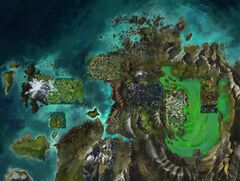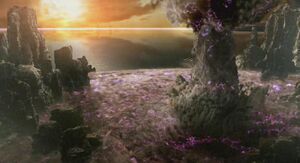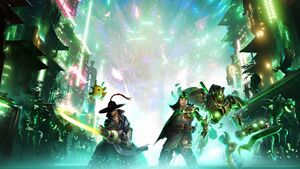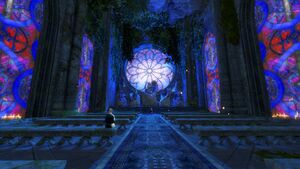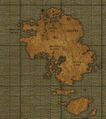Cantha
“Over two centuries ago, the Empire of the Dragon severed all bonds with central Tyria and Elona. Cantha has its own history of turmoil and triumph, reflected in ancient landmarks, enduring artistry, and modern life.
Cantha is a continent to the south of Tyria. Cantha has mostly been ruled by a single empire, called the Empire of the Dragon or, alternatively, the Dragon Empire[1][2] or the Empire of Cantha.[3][4] It is an ancient land that has been occupied by humans in the northern part of the continent and is the oldest known location of human settlement.[5][6] The empire was formed by the warlord Kaineng Tah when he joined the coastal tribes of the mainland.
Although Cantha has its own history, over the years it has suffered from the Jade Wind event, internal wars, criminals, isolation and the Great Tsunami. Despite this, Cantha has stood firm and today is a prosperous place with a strong empire.
Empress Ihn, a direct descendant of the empire's founder Kaineng Tah, still rules the continent today.[5]
Getting there[edit]
- The Guild Wars 2: End of Dragons expansion is required to access this region.
- Activate the End of Dragons story in your Story Journal in the hero panel, and finish the Old Friends story step to gain access to Seitung Province.
- Alternatively, if your guild has the Isle of Reflection guild hall you can enter your guild hall via the guild panel and then walk through the exit portal.
- If you have obtained the Arborstone Portal Scroll while playing the story with a character, alternate characters at level 80 can use the item to teleport to Arborstone and then, just like before, simply have to walk through one of the exit portals.
- With Arborstone unlocked, you can also travel there by the Asura Gate at Coriolis Plaza in Lion's Arch, or via Monteco, the Maitre'd in Lava Lounge.
- The Thousand Seas Pavilion, accessed by purchasing a Gem Store pass, can be used to teleport to all 4 Cantha maps, too, via the Portals to Tyria.
- Traditional travel to unlocked waypoints in Cantha from the rest of the world is relatively expensive because of long distance (about 10
 or more for level 80 character); the closest area is Domain of Istan (accessible in Living World Season 4) or other zones in Vabbi region.
or more for level 80 character); the closest area is Domain of Istan (accessible in Living World Season 4) or other zones in Vabbi region.
Locations[edit]
Interactive map[edit]
History[edit]
Origins of the continent[edit]
| A secluded area later known as Mother's Lament, located in southern Dragon's End of the Jade Sea in eastern Cantha, is where the world of Tyria began taking form and where life first flourished in eras long past while various spirits roamed and began taking physical form on this nascent material plane.[7][8] The location that would one day see the building of the Harvest Temple was the first in the world of Tyria to contain a major ley line hub underneath it to direct the flow of magic.[9][10]
The Elder Dragon Soo-Won was the first physical being to exist on this developing world and helped nurture life by weaving the multiple domains of magic. In so doing she helped stay the Void's unrelenting push toward entropy which would have led to Tyria and all life on it dissolving back into the primordial state in the Mists if left unchecked. To both assist her in this crucial task to preserve the world and to not feel alone, Soo-Won brought her five children—Jormag, Kralkatorrik, Mordremoth, Primordus, and Zhaitan— into being and split the domains of magic so each of these new Elder Dragons got their respective domain and the responsibility to balance the magical Antikytheria system of the All while she retained control over the water domain. However, the gifted magic began influencing the young Elder Dragons who developed their own personalities and desires as they grew up, and their differences ultimately led to clashes between siblings and their mother before they all went their separate ways to establish their domains in the forming regions across the world.[7] |
Pre-imperial era[edit]
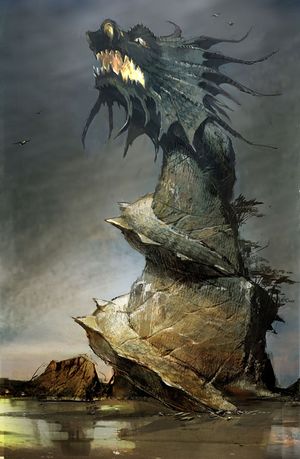
The time before the founding of the Empire of the Dragon is referred to by humans as the pre-imperial era, which is further divided into loosely defined early, middle and late pre-imperial eras. This is because the Canthan calendar lacks the precise means of recording dates before 0 CC, which corresponds with 510 BE in Tyria's Mouvelian calendar.
Dragons of all shapes, sizes, and origin have called Cantha home for thousands of years, since long before the human tribes of old arrived on the continent and joined to form the empire that took dragons as its symbol.[11] Despite this, in contrast to the northern continent of Tyria, the extent to which Canthan prehistory had been shaped by the Elder Dragons remained unknown to scholars who chronicled Cantha's early history, except that the early pre-imperial era would later be mentioned in the context of Central Tyrian research about the cyclic nature of Elder Dragon awakenings once modern Tyrians became aware of the Elder Dragons' existence and their actions during previous dragonrises.[12]
Later scholars have presented a hypothesis that Canthan humans may have known about the Elder Dragon of Water since the Dragon Empire's founding because dragon iconography and reverence has appeared in Canthan historical records for thousands of years and because there have been illustrations and descriptions of statues far grander in scale than the saltspray dragons that Canthans were more familiar with. According to this hypothesis, the friendlier naga of the era, well versed with ancient history among their people, may have spun stories about the Elder Dragon to early human settlers if they knew of her existence in some manner.[2]
In terms of the "elder races" (that is, races that were around at the time of the last dragonrise), there is evidence of a Forgotten presence in Cantha,[13] as well as relics of a mysterious race speculated to be an offshoot of the Deldrimor dwarves,[14] dating back to before humanity's arrival in the world of Tyria. The buildings of the Altrumm Ruins in the Echovald Forest also serve as evidence of a pre-human civilisation in Cantha, but their architects are unknown.
In 786 BE, the Six Human Gods first appeared in Cantha, bringing humanity with them.[6] The Luxon and Kurzick tribes did not emerge from the Canthan people and arrived separately at a later time, in unclear circumstances,[13] as did the human tribes of the northern continents of Elona and Tyria. Cantha has been said to have been settled by humans multiple times in the pre-imperial era, suggesting that the tribes that would one day become known as modern Canthans were only the latest colonizers of this fertile land.[13]
Age of the Marmoset (510 BE–205 BE / 0–305 CC)[edit]
In 510 BE, the Canthan tribes united under a single leader, the warlord Kaing, and established the Empire of the Dragon while marking the historic date with year 0 in the Canthan calendar. Kaing took the mantle of emperor as Kaineng Tah and founded the Imperial Family lineage. He ordered the construction of Raisu Palace as his seat of power in the same year. Kaineng Tah was said to have fathered over two hundred sons and daughters both with his wife and thirty favored concubines. This meant that although the throne had not always passed directly from father to son over the centuries to come, it had always gone to one of royal blood—at most, a first cousin as seen in several well-documented cases. The first emperor died under mysterious circumstances in 46 CC (464 BE) while riding his favorite horse on a hunting expedition. Although official history describes Kaineng Tah's death as purely accidental due to him falling off the spooked horse, fragmentary records have mentioned unexplained wounds on his usually trusty and well-trained horse's rump and on the emperor himself with a few records even suggesting some involvement from his fellow huntsmen.
It is unknown whether Kaineng Tah left a will behind to declare his eventual successor although contemporary writings by the emperor himself indicated that the document might have existed at some point. However, no will was ever officially discovered, leading to later scholarly speculation that the will might have been destroyed. The throne passed on to the older of Kaineng Tah's two sons, Yian Zho. The new emperor's two elder sisters were neither consulted nor welcome in the succeeding government. The sisters' fates remain unknown, but they vanished from the record weeks after Yian Zho had taken the mantle of emperor.[13]
During Yian's reign, the Luxon and Kurzick tribes united into two nations and seceded from the empire, only to be forced back with military might and diplomacy as vassal states as Yian Zho's army was unable to fully annex the two tribes' territories. This time was also the birth of the hostility between the Luxons and Kurzicks that would remain for over a thousand years. After Yian Zho's reign, Cantha remained fairly isolated in the south, only opening trade with the northern continents centuries later in 731 CC (221 AE), when resources became low for their growing population.
Age of the Falcon (205 BE–1 AE / 305–510 CC)[edit]
The Age of the Falcon, which spanned from 305 CC (205 BE) (the year that humans first appeared on the northern continent of Tyria) to the Exodus of the Gods, was an age of isolationism. By this time, the Empire of the Dragon was already sprawling,[13] and had little impact on the development of the Kingdom of Tyria (which would, after the Exodus, fragment into the kingdoms of Ascalon, Kryta, and Orr). This era also marks the granting of the gift of magic to the mortal races of Tyria, including humans in Cantha (whose ritualists already had something which they called "magic", but was actually power granted to them by ancestor spirits).
Age of the Bat (1–221 AE / 511–731 CC)[edit]
The gift and subsequent partial revocation of magic caused the widespread practice of the heroic professions, including in Cantha. Chanang, the eldest prince of the imperial line, defied the wishes of his father and chose to follow the hero's path. He became a warrior/monk and an ascendant. Upon succession as the eleventh emperor, he refused the title of "lord emperor" and became the first "ascendant emperor" as Chang Hai. Since then, all emperors have been required by family tradition to practice at least two of the heroic professions.
Age of the Hedgehog (221–694 AE / 731–1203 CC)[edit]
731 CC (221 AE) marked the first formal contact between the Empire of the Dragon and the kingdoms of Tyria. Cantha provided valuable knowledge and technology to the less advanced kingdoms, and in return received badly-needed resources. This allowed the recovery of Shing Jea Island, which had been damaged by overlogging, to begin, eventually transforming it into pastoral agricultural land.
Age of the Tortoise (694–872 AE / 1204–1382 CC)[edit]
The Age of the Tortoise began with the death of the tyrannical Singtah, the 23rd emperor, and the burning of the first Raisu Palace. It continued with his son Emperor Senvho's reconstruction of the palace, a task which obsessed him and consumed him for the remainder of his eighty-year reign.
Age of the Dragon (872 AE–? / 1382 CC–?)[edit]
The Jade Wind[edit]
The Jade Wind was a formative event in Canthan history. It occurred when the bodyguard Shiro Tagachi assassinated his master, the 26th emperor of Cantha, Angsiyan. Shiro was a formidable warrior in his own right, but he also performed a number of dark rituals in preparation for his actions.
Shiro did not live long after committing the murder. Three of the emperor's guard, the Luxon spear master Archemorus, the Kurzick Saint Viktor, and the assassin Vizu, attacked him. In a climactic battle, Archemorus and Viktor were able to wrestle Shiro's swords from him and, turning them against their wielder, nearly slice him in two. In Shiro's final moments, he called upon dark powers and sucked out the fallen emperor's very soul. Tagachi's death cry released the foulest of magic, a horrific wail that rose like a gale over the land. This Jade Wind spread from the temple, turning the sea into solid jade and petrifying everything it touched (trees, animals, and people) within the Echovald Forest.[15]
The newly crowned emperor, the late Angsiyan's son Hanjai, took the throne while the empire was on the verge of collapse due to the aftermath of the Jade Wind. Tales tell how Hanjai prayed to the ancients for guidance, to seek a way to reunite his people and restore glory to the troubled lands. His prayers were answered in the form of a mighty celestial dragon that swooped from the heavens and assured him that Cantha would rise once more. The inspired Hanjai poured every ounce of his blood, sweat, and tears into achieving that goal by bringing Canthans together via offering refugees a place to stay in within the Kaineng City, making the land as safe as he could in the aftermath of the Jade Wind, and restoring leadership.[1]
The next summer, Hanjai instituted the Dragon Festival. It was meant to commemorate those who had lost their lives in the Jade Wind, unite all denizens of the empire, and celebrate the establishment of a community on Shing Jea Island.[5] It also symbolised the survival of the Empire of the Dragon in the face of calamity. The emperor and his subjects would bow their heads in respect as they prayed for the blessings of the Celestial Dragon while invoking its name.
At some point, this celestial dragon spirit—potentially the Cardinal Celestial Tahmu or the Celestial Dragon—became regarded as the figurehead of the empire.[1]
Tengu Wars and division in Cantha[edit]
In 880 AE, tension rose between the people of Cantha and the tengu as Canthan farmers began settling Shing Jea Island. At first, it was a simple matter of territory and the fighting was kept to a few skirmishes. War nearly broke out when the Sensali clan of tengu massacred an entire village and, according to reports at the time, consumed the bodies of those killed. While Emperor Hanjai's ambassador was able to avoid open war with the Angchu clan of tengu, the Sensali clan declared the Angchu traitors and continued their acts of aggression.
Cantha's trade agreements with Ascalon, Elona and Orr stood until 902 AE, when they were dissolved by Emperor Hanjai, beginning one of the the most isolated period in the empire's history.
In 1017 AE, the Luxons and Kurzicks ceased regular diplomatic contact, communicating with each other only through liaisons of the Celestial Ministry when absolutely necessary. For many years to come, they would remain more focused on their divisions than on the problems that damaged their lands from within.
Kintah, the 27th emperor, was known as a man of the people. He informally reopened trade between Cantha and the Tyrian and Elonian kingdoms in 1022 AE when Loremaster Ermenred of Ascalon was able to negotiate a visit to the continent and Shing Jea Island to tour with Cantha's new emperor.[13]
Continued settlement of Shing Jea under Kintah's successor Kisu since his ascension to the throne in 1058 AE led to the Canthan farmers passing on diseases to the tengu and their hatchlings. Being forced to kill their young and their brethren, the tengu sought revenge and escalated their acts of aggression.
In 1071 AE, Wona, the emperor's minister of war who had fought against the tengu for many years, contacted the tengu chieftains Swift Honorclaw and Gull Hookbeak of the Angchu and the Sensali clans and requested their presence for a summit to negotiate peace between humans and tengu. Emperor Kisu asked his half-brother, Master Togo, to accompany a delegation to the war minister's estate as an observer of the proceedings and to legitimize the talks. However, the summit was a trap by Wona who intended to kill Togo and pin the blame on the tengu, creating the pretext for a genocide.
Togo was able to rally the remaining human delegates behind him to stop Wona's plans while promising the tengu to bring back the war minister's head as proof that the emperor was not behind the plot. The tengu leaders sent Talon Silverwing with Togo to find the minister and kill Togo if he proved to be deceitful. Togo turned out to be a man of his word, however, and killed Wona after fighting through the minister's defenders. While the Sensali left the summit in distrust and retreated to their raiding ways, the more civilized Angchu seized the opportunity for a real truce. Togo brought the tengu's complaints to Emperor Kisu and hammered home a peace treaty after 191 years of hostility, becoming a respected figure among the Angchu.[16][17]
One year after the Tengu Wars had officially ended, the humans and the tengu began holding an annual festival at Shing Jea Monastery to celebrate the anniversary of the peace accords. This festival became known as the Day of the Tengu and was attended by Emperor Kisu himself who held a speech to the festive crowd.
Return of the Betrayer[edit]
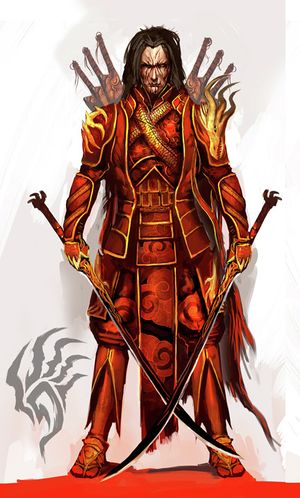
- See also: Storyline of Guild Wars Factions
Two hundred years after the Jade Wind, events occurred that revealed Shiro Tagachi's evil was not fully destroyed. The heroes of Tyria joined forces with Emperor Kisu, his half-brother Master Togo, and Togo's former student Brother Mhenlo.
The journey began with the appearance of a horrible plague, which turned the victims of the disease into violent creatures, called the Afflicted. After researching the disease, the group found evidence of Shiro Tagachi, a man long dead. However, beings from the afterlife, called envoys, told them that Shiro was turned into a spirit. The envoys' task, as penance for crimes committed in life, was to guide the souls of the dead. Instead, Shiro was corrupting the spirits, merging them with magical constructs called the Shiro'ken and building an army.
The group attempted to destroy Shiro, but were unsuccessful. They needed allies. Emperor Kisu was easy to convince, the Oracle of the Mists, Suun, also contributed valuable knowledge. After several negotiations, they convinced the Canthan vassal states of Luxon and Kurzick to join them. The dragon Kuunavang taught them valuable skills and agreed to fight alongside them.
Finally, the group ascertained Shiro's final goal. He was trying to return to life, and he only needed one more thing: to spill the blood of a member of the imperial bloodline. Togo, Mhenlo, and the heroes wasted no time in returning to the palace, but they only arrived at the last second. Battling their way through the Shiro'ken, the group reached the Imperial Sanctum to find Shiro standing over Emperor Kisu, about to give the final strike. Master Togo, in a desperate act, rushed to his half-brother, taking the blow. The emperor was saved, but Togo sacrificed himself—and Shiro, with his quest now complete, had achieved his goal. The betrayer left to complete his spell, leaving the survivors behind to mourn a great man.
In attempt to avenge his teacher, Mhenlo rushed into the Imperial Sanctum to confront Shiro, and the group followed him. They found Shiro Tagachi fully restored, a deadly and formidable assassin—but once again, a mortal one. A terrible battle ensued, but the party was able to bring down Shiro. As Shiro lay dying, the Oracle Suun appeared, using his power to encase Shiro's body in solid jade. The envoys also arrived, seeking Shiro's soul. The last remnants of Shiro Tagachi were consigned to a special place in the Underworld, where his spirit was imprisoned and forced to answer for his many crimes.
Winds of Change[edit]
- See also: Storyline of Guild Wars Beyond
Though the Betrayer was stopped, the plague persisted in Cantha. Countless lives were lost, from the families of people forced to live in the streets to prominent families like the Yuudachi, head of the Sai Ling Order. Ashu Yuudachi survived the slaughter under miraculous conditions, and came into the care of his aunt, Reiko Murakami.
In 1073 AE, Reiko, then a member of the Ministry of Flame, made her first strides toward rallying the people of Cantha to fight back against the Afflicted. With Ashu at her side as a symbol of hope, her message resonated with the people. Little by little, Canthans began to take their fate into their own hands. Reiko began to rise in the ranks of the Ministry of Flame, as she and Ashu became renowned public figures. They spoke more often with the people of Cantha, offering the promise of change and the hope for a better future, free of the Affliction. Over the next couple of years, Reiko would become increasingly dissatisfied with the restrictions of the Ministry of Flame. Finding flaws in the system—the needless bureaucracy, political maneuverings, and personal agendas—she came to the conclusion that something greater needed to happen if Cantha was ever going to be able to move forward.
In 1077 AE, Reiko officially established the Ministry of Purity, with Ashu as a central figure. The Ministry of Purity made dealing with that which harmed Cantha its goal: to take action when all other branches of the government were content to turn a blind eye, pass the issues off as the emperor's problem, or fault the other ministries. Two years later, the Ministry of Purity began in earnest its campaign to finally rid Cantha of the Afflicted. Brave men and women rallied to their cause, eager to make their homes safe once more. In the course of the campaign, which lasted under a year, the Afflicted were vanquished alongside many members from the Jade Brotherhood and Am Fah gangs, and the tengu were branded as traitors and routed. The Ministry then set its sights on sweeping social reform.
In 1080 AE, Reiko's ambitions were exposed, and word was sent to Emperor Kisu about her attempts to eradicate the tengu and oppress any Canthan who stood in her way. However, Kisu was unable to act against the Ministry of Purity, whose influence was growing beyond his control, out of worry that divided loyalties between their respective followers would lead to an endless civil war.[18] Reiko was eventually assassinated by her niece Miku Yuudachi and the Hero of Tyria who were assisted by discontent Shing Jea peasants led by Xin Ji, Angchu tengu led by Soar Honorclaw, survivors from Am Fah and the Jade Brotherhood led by Daisuke Crimson Edge and Eri, Heart of Fire, and even the atoning Ministry initiate Zei Ri. They believed that Reiko and the ministry, in their zealotry to fight evil, had become a threat to themselves and to others with the way they violently oppressed those that did not fit their ideal of a purified Cantha. Miku believed that she was rescuing her brother Ashu from Reiko's grip; however, Ashu refused his sister's protection after Reiko's death and took control of the Ministry of Purity, pledging to show the people of Cantha the correct path to walk and to make Cantha whole again while claiming to not repeat Reiko's mistakes. Those participating in the uprising against Reiko lamented that many Canthans would mourn Reiko's passing despite her crimes and would view the Hero as a criminal.[19]
Contact lost with the other continents[edit]
- See also: The Movement of the World
By 1127 AE, the people of Tyria were on their own. The new Canthan emperor, Usoku, finally unified his continent into the Empire of the Dragon. His armies conquered the vassal states of Kurzick and Luxon, making his power absolute. These efforts were supported by the Ministry of Purity,[5][20] which had originally been established by Reiko Murakami to combat the Afflicted. Usoku began to purge the lands of rebels, the sick, and any non-humans,[21] including the tengu who were forced to flee north to Elona and Tyria before many tengu tribes from Cantha, Elona and Tyria eventually built a new sanctuary called the Dominion of Winds for their persecuted clans.[22] It was not long after the purges that Canthan embassies started to follow Usoku's isolationist policies.[23] Regardless of this isolation, the Empire of the Dragon continued to do trade with Krytan royalty by trading Canthan silk and other goods for Krytan cotton.[24]
The Rising of Orr, caused by the awakening of the Elder Dragon Zhaitan in 1219 AE, completed Cantha's isolationism as the southern seas became dangerous to travel for sailors due to the increasing menace of Zhaitan's Risen minions patrolling the waters on black ships around Orr.[25][26] Due to this blockage, the last contact had was from the Canthan tengu who, led by a descendant of Talon Silverwing, forced their way through the Risen forces.[27][28][29] Usoku became the last Canthan emperor whose name Tyrian scholars knew.[30]
Later, Emperor Kyobok and his wife Empress Ha Rin met at Raisu Palace when Orr's revival resulted in a great tsunami that struck Cantha in 1729 CC. The emperor and most of his family, along with the royal guard and servants, were at the Raisu Palace at the time and witnessed the flooding of Old Kaineng City firsthand. Kurzick ambassadors Asmund zu Heltzer and Eira zu Heltzer were also in the palace, presumably as prisoners.[31] Witnessing the impending catastrophe, Kuunavang sought help from the Elder Dragon Soo-Won as no one else had the power to stop the great tide. Soo-Won arrived in Cantha and used her power over water to create another great wave to counter the effect of the tsunami, saving Cantha. Soo-Won earned the status of a legendary hero with the deed although both she and Kuunavang disappeared soon after.[32]
In the century that followed, occasional sporadic Canthan sailors would wash ashore along the Maguuma Jungle, being the only proof Tyrians had that Cantha still existed.[25] Despite this, Cantha's influence continued to affect humans in Central Tyria up to the present day as many families of Canthan origin settled there. Divinity's Reach, capital of the kingdom of Kryta, dedicated an entire city district to refugees and immigrants from Cantha, until the district was destroyed in the Great Collapse in 1325 AE.
Interim years[edit]
Inspired by the Pact's victory over Zhaitan in 1325 AE, Captain Hao Luen of the Captain's Council reimagined Tyria's version of the Canthan Dragon Festival as Dragon Bash, a festival to celebrate the defeat of the Elder Dragons, in Lion's Arch in the same year.[33] After the Great Collapse had been turned into the Crown Pavilion, Divinity's Reach had activities centering around Lunar New Year to celebrate the Canthan new year.
Despite Cantha remaining inaccessible to the common Tyrian and Elonian, it is hinted that the Zephyrites managed to reach Cantha aboard their floating Zephyr Sanctum and traded with the locals as recently as 1327 AE.[34][35][36]
In 1331 AE, the asura scholar Taimi reaffirmed the cases of Canthan sailors washing ashore, furthering that they had recounted tales of strange, and previously unknown, creatures emerging from the ocean. Taimi speculated the creatures from the tales to be connected to the deep sea dragon.[37]
Border reopening[edit]
“I get it. Your people withdrew from the world; now you're rejoining it. There is risk. There is also promise. Our nations have an unprecedented opportunity. No need to waste that over a...misunderstanding.
In 1335 AE, Cantha faced a major crisis when the Aetherblade pirates, followed by the dragon Aurene and the Pact Commander, arrived on Shing Jea Island. The Commander, detained and later released, tackled the Aetherblade threat while helping Aurene recover from a magic-draining weapon. They met Empress Ihn and Lady Joon, a jade tech expert, to resolve the Aetherblade issue and assist Aurene.
The Commander's investigation led them to confront dredge loyalist Ivan and Aetherblade leader Mai Trin, who eventually assisted in tracking down her associates. The team's journey took them to New Kaineng City, where they encountered technical issues and jade mechs gone haywire. Here, they learned about Elder Dragon Soo-Won's voluntary role in stabilizing Tyria's magic.
In Echovald Forest, the Commander and allies uncovered the truth about Navan, who was actually Kuunavang the Saltspray dragon, and fought Void-corrupted forces. Their pursuit of Ankka, an Aetherblade, revealed her plot to harness Soo-Won's magic. Ankka's eventual defeat and Soo-Won's corruption by the Void led to a series of intense battles.
The Commander's efforts culminated in a massive confrontation at the Jade Sea. With allies like the Kestrels, Aetherblades, and Canthan ministries, they faced the Void and its army. After a fierce battle, they defeated the Dragonvoid, marking the end of the Elder Dragon cycle and the beginning of the Age of Aurene.
Reflecting on these events, the Commander and allies considered the future, while Empress Ihn moved to establish diplomatic ties with foreign lands. This period marked a significant turning point in Canthan history, ushering in an era of change and new alliances.
Geography and climate[edit]
The continent of Cantha is located south of all of Tyria, beyond the Unending Ocean passing through Elona and the The Battle Isles.
Cantha, the Dragon Empire contains seven different known regions: Shing Jea Island is an archipelago with a temperate climate full of cherry blossom trees and forested and mountainous areas, it has beaches, it even has a snowy area. While New Kaineng City is a megalopolis with gigantic buildings and canals where you move through skiffs, however Kaineng Old City is a area devastated with the Zhaitan Disaster that flooded the place and is currently abandoned and full of risens that have invaded the place.
The Echovald Forest is a region that was previously petrified by the Jade Wind, although currently the forest has begun to come back to life and is full of wildlife and is quite wooded in which there is little light due to the huge trees that block most of the sunlight. The Jade Sea was previously a watery area where marine life was seen, with the Jade Wind the sea petrified and the life that once existed remained petrified, however many centuries have passed and the sea begins to melting, which is why there are areas that return to their aqueous state once more, although it has also begun to be affected by the extraction of the jade that is inside, for which it has been seen that it is With certain parts dried up where previously it was full of jade, it can also be seen that the sea has some islands in its interior where wildlife is maintained and several cliffs can be seen.
The Great Turtle Highlands is a mountainous region just like Kirin Peak.
List of regions[edit]
These are labelled on the world map but are considered lore regions.
Accessible regions[edit]
Shing Jea Island is the largest of a chain of islands to the west of the northern tip of the Canthan mainland. The island contains important and historical sites, and is the main point of arrival in Cantha for foreign visitors. The island is idyllic and rural, it is a place full of life, vegetation, beaches and coasts, where it is inhabited by humans, tengus and some nagas.
Originally, the city of Kaineng was located in the northern part of the Cantha continent, but with the awakening of Zhaitan, the old city was destroyed by the tidal wave, and currently the new city of Kaineng changed its location.
New Kaineng City is now a modern metropolis with tall buildings and canals serving as skiff streets, residential areas, neighborhoods, laboratories, and part of old Kaineng. It is currently a center for jade technology provided by Xunlai Jade. Although within the same city there is a group of bandits such as the Jade Brotherhood that is dedicated to sabotaging and causing blackouts and the Purists who oppose the government of the Empress Ihn.
The largest Forest in Cantha, Echovald Forest was the home of the Kurzicks before they were conquered by Emperor Usoku. When he struck the Jade Wind, the trees and wildlife were shot into stone, petrifying it.
During the following years after Shiro Tagachi's defeat life began to sprout again, the damage caused by the Jade Wind has been reversing. However, in recent years it has begun to be threatened by contamination from the Xunlai Jade Junkyard.
The Jade Sea is an inland sea of Cantha with a greenish hue. Many centuries ago it was navigable to the ships of the Luxons and was a part of their home. When the Jade Wind caused by Shiro Tagachi was unleashed, all marine life along with the sea became petrified. During the years following Shiro Tagachi's defeat, the sea has begun to return to its watery state.
Although in recent years with Soo-Won's magic, with the help of Joon and the Xunlai Jade some of Soo-Won's magic has been redirected into the sea to create what is now called Draconic Jade, which is a mineral that It is extracted to create technology and energy for the empire, although there are parts of the Jade Sea that have been drying up due to the same extraction.
Inaccessible regions[edit]
It was formerly the original city of Kaineng in Cantha. It was destroyed about 100 years ago by the awakening of the Elder Dragon Zhaitan. This is where the Raisu Palace was located where the emperors ruled the entire empire and it is also where the Tahnnakai Temple was where the statues of the greatest heroes of Cantha were and a temple dedicated to the Six Human Gods resided.
Though the place is now riddled with Risen where danger lurks, there are still plenty of people who venture here, searching for history and lost treasures.
It is an area north of the Jade Sea, it is a mountainous area.
It is an area south of Cantha
Demographics[edit]
Language[edit]
- The Guild Wars Wiki has an article on Old Canthan.
- See also: Designing the Canthan Written Language
Religion[edit]
Religion in Cantha is diverse, although the main one and the one that has been most revered for years is that of the Six Human Gods. Most, apart from believing in the Six Gods, have their other deities.
As of 1072 AE, the worship and perception of the Five True Gods within the Empire of the Dragon had taken on a uniquely Canthan cast. The greater gods of the pantheon shared the Canthan heavens with an assortment of lesser demigods, as well as eternal ancestor spirits and legendary heroes granted divine status by the diverse inhabitants of the realm.[11]
- Dwayna is often depicted as young, tall, and slender, rising above the ground on huge feathered wings. Canthan artists often depicted her floating above the vibrant, living souls of their eternal ancestors.
- Balthazar is frequently shown holding a greatsword, its tip lodged in the ground, with a pair of battle hounds sitting at attention at his feet. In Cantha, the sword was usually one of the single-edged imperial style, and the battle hounds were usually replaced with winged drakes.
- Statues of Grenth depict the god with the body of a man and the narrow, skeletal head of a beast. Canthan artists tended to add a draconic look to the skull. The Canthan version of Grenth stood astride a small mountain of the dead, but in Canthan art the faces of these corpses were always averted from the god of death, as if in shame, to distinguish these enslaved dead from the "living" ancestor spirits.
- In Cantha, Lyssa was not only the goddess of beauty and illusion, but also represented the incarnation of luck, both good and bad. Many Canthan assassins revered Lyssa more for her intrinsic duality than her famous beauty, and had been known to invoke her charms. Depictions of Lyssa in Canthan culture reflected the typical northern style: lithe twin figures of exquisite beauty entwined in an eternal dance.
- Melandru was frequently depicted in Cantha as a tall, winged dryad from the waist up. Canthan artists usually described a severe figure ensconced in an outcrop of Echovald quartz. Melandru's roadside temples offered shelter, food, and water to weary travelers even in Cantha, though such shrines were few, and separated by long stretches of lifeless stonescape.
- After the Ascension of Kormir in 1075 AE, Emperor Kisu decreed that the Dragon Festival, celebrating the Celestial Dragon, also be a commemoration of the great battle against Abaddon and Kormir's rise as the new Goddess of Truth.[38]
There are no known Canthan depictions of Abaddon or Dhuum.
- Soo-Won - Nowadays it seems that many have lost faith in the gods, so some see Soo-Won as a savior and protector.
Other religions are:
- Three Queens - are three legendary demigoddesses known as Alua, Elora and Ione, worshiped by the Luxons, after Emperor Usoku unified Cantha, faith in them has faded gradually.
- Saints - are patron saints, who used to be an ancestor of one of the Great Houses.
- Celestials - are the physical embodiment of the spirits of the stars, Canthians revere the Great Celestials. Apart from the great celestials, there are others that by tradition on the Lunar New Year, the associated Celestial of that year is said to bring with it the new year, to ensure good fortune for all Canthians.
- Spirits - are spectral beings that wield special magical powers. Many spirits become guardians of the places where they appear. Cantha spirits rise or fall depending on how much they are revered and the places in which they live.
Culture[edit]
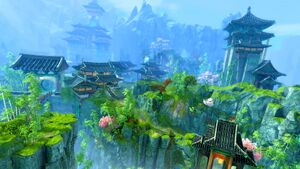
The Canthian culture was divided into four styles of which two were the Kurzicks and the Luxons, now there are only two styles, rural and urban Canthian. There are some unified aspects, such as the Canthan calendar based on a lunar system, as opposed to the solar system of the Mouvelian Calendar. Their annual celebrations are the Lunar New Year where the associated Celestial of that year brings in the new year and where a great banquet is prepared, and lastly there is the Dragon Festival is an ancient festival where Emperor Hanjai, son of Angsiyan, turned this ancient tradition into a large-scale celebration in order to to unite the empire in its reconstruction. Likewise, all Canthians have a great reverence for the moon, which they call the "moon of Melandru".
Historically the Dragon Empire was led by an emperor and administered by the Celestial Ministry and later with the return of Shiro Tagachi a new ministry was formed, the Ministry of Purity to eradicate the Plagued plague. Now the empire is administered by the Empress Ihn and the Ministries of Cantha.
The empire in recent years has advanced towards modernity, thanks to the Xunlai Jade developing power plants, robots, and other new technologies using the Dragonjade, improving the lifestyle of every Canthan. One of these novelties are holodramas[39] which have started gaining popularity in recent years. Two popular holodramas are The Ministry Diaries, a series about Ministry workers and their erotic life,[40] and another one involving a minister moonlighting as a detective to solve mysteries.[41]
- Rural Canthan
The Cantha countryside, particularly on Shing Jea Island is used for crops and fish, and thus supply the towns, villages and large cities, such as New Kaineng City.
The place is home to the Daigo Ward which serves as a residential area where the Ministry of Traffic which gives permission to visitors to travel around Cantha and you can also see the Shing Jea Monastery where for generations it has been a place for students of various arts and professions and, houses the Royal Court which serves as a replacement for the Raisu Palace where the empire is administered. Like it has several temples.
In the Echovald Forest you can see some villages where the tengu live with the humans, as in the case of Qinkai Village, some of these villages they live from the fish market that is near some lake, or some of them still extract amber in the case of the Altrumm Mines however it is not as expensive or as used as the jade. The northern part of Echovald from what can be seen there are rivalries between some factions where you can see the Gang War of Echovald, among them are the Speakers, the Jade Brotherhood and the Kestrels.
In the case of the Jade Sea, most of them are quarries and some towns that live as miners, where they are dedicated to the extraction of draconic jade. There are some monasteries, sanctuaries or temples in its surroundings, which have history.
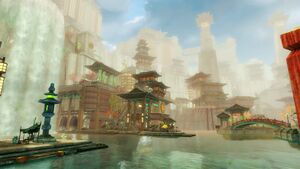
- Urban Canthan
The Dragon Empire has two cities that are divided into two parts, which would be the part of Kaineng Old City that is flooded, in ruins and full of risens. Previously it housed the headquarters of the Celestial Ministry and the Raisu Palace where the emperor ruled and had the Tahnnakai Temple that had two divided sections, one dedicated to the Six Human Gods and the other part to their great heroes.
And the part of what is now New Kaineng City that is made up of tall buildings in which you can move through Zip Lines and water channels that serve as streets where you can move with zip lines skiffs. It has residential areas and places where poor people live, such as the Grub Lane area. And it is where the headquarters of the Cantha Ministries and the Xunlai Jade power plants are located.
There is also a huge Jade Monument here which is dedicated in honor of Soo-Won for saving Cantha from the flood caused by the Zhaitan Disaster.
- Luxons and Kurzicks
The Luxons and the Kurzicks were the two most populous and distinct vassal cultures of Cantha. During Emperor Usoku's reign, these two were killed, several escaped, and many more were united under the Empire.
Prior to is the nation of the Kurzicks were led and directed by the Council of Nobles and their culture by the Great Houses: House zu Heltzer, House Vasburg, House Brauer, House Lutgardis, and House Durheim. The Kurzicks were very religious people who took the worship of the Gods and their saints very seriously. The characteristics of the houses were based on the idea of art, music and religion.
For their part, the Luxons were led and directed by the Council of Elders and their three clans: The Crab, The Serpent, and The Turtle. They were nomads and before the Jade Wind they used to sail throughout the Jade Sea The Luxons had their own demigoddesses known as the Three Queens: Alua, Elora, and Ione. Although they also worshiped the gods Balthazar, Grenth, and Lyssa, the former two were worshiped for their combative nature, and the latter was worshiped for the beauty of its architecture.
After the annexation of these vassal states, all that remained were ruins and descendants that are now scattered.
Government[edit]
- See also: Ministries of Cantha
“In the old days, the emperor's word was law. Cantha's moral compass was directed by one man. Or woman. Usually a man. Times have changed. We're not exactly a democracy, but our society is shaped by many voices.
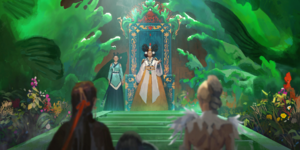
Historically, while led by an emperor, the Empire of the Dragon has been managed by the Celestial Ministry, which is primarily made up of the Ministries of Earth, Fire, Water, and Air.[11] After the return of Shiro Tagachi, a new ministry was formed, the Ministry of Purity, which quickly rose through the ranks of power as they gained the population's support through eradicating the Afflicted plague.
During Emperor Usoku's rise to power, the Celestial Ministry continued to serve alongside the Ministry of Purity, which had greater power and influence. As time passed, Empress Haebaragi dissolved both the Heavenly Ministry and the Ministry of Purity to create the Ministries of Cantha. Each ministry has a function and serves a different task, such as the Ministry of Security that is dedicated to protecting and safeguarding people's lives, the Ministry of Archives that is dedicated to collecting history, the Ministry of Transit that grants travel permits for Traveling through Cantha, all of these ministries serve in conjunction with Empress Ihn, who is the current monarch of the Dragon Empire.
The Imperial Family of Cantha represents the longest known unbroken line of ancestral succession seen on the world of Tyria. Previously up to the reign of Empress Haebaragi, the Cantha Empire had always been ruled by the previous emperor's closest male relative, and the title of "empress" had been bestowed only through marriage and had little real power in the past patriarchal society of Cantha.
Gallery[edit]
- Maps
Cantha on the Durmand Priory's map of the world.
Cantha on a fan's map of Tyria.
- Citizens
Female peasant, concept art by DAZE.
Notes[edit]
- The Empire of the Dragon, as of last contact, practiced agnatic primogeniture as its succession law, although there has been at least one Canthan empress (although not necessarily an Empress of Cantha). This seems to have changed in recent years with Empress Ihn.
- Concubinage was practiced in Cantha, by emperors from Kaineng Tah to Kintah.[13]
- The book Winds of Change found in the Durmand Hall suggests that Cantha has not been affected by the current dragonrise, at least prior to the rise of Zhaitan when contact was lost with Cantha.
- A group of dredge once tunnelled to Cantha from Sorrow's Furnace, escaping from their Stone Summit dwarf masters.[42] Their fate is not known, given Emperor Usoku's purge, and their tunnels are presumably no longer accessible due to the minions of Primordus.
- There used to be an asura gate beneath Cantha, indicating that the asura under-empire stretched at least that far south.[43] This gate was part of the first asura gate network, which is now unusable after Primordus's rise destroyed the Central Transfer Chamber.
- Several low-resolution textures depicting a world map of Tyria, such as the map in the Durmand Priory or the Order Threat Assessment Board, depict Shing Jea as being a peninsula rather than an island, as it was in Guild Wars Factions. These maps also do not depict the Jade Sea as an inland sea but as part of the landmass, but this may just be because Cantha's isolationism makes it impossible to know its current internal geography.
- Official maps released by developers have shown Shing Jea as an island and the Jade Sea as a solid landmass.
Trivia[edit]
- In Guild Wars Factions, the Empire of the Dragon was inspired by a blend of different Asian cultures.
- Kurzick and Luxon names were respectively more German- and Greek-flavored.
- The overall art direction for the Kurzicks faction was inspired by Gothic architecture, while the overall art direction for the Luxons faction was inspired by Southeast Asian cultures.
- Luxon may be a reference to Luzon island.
- At one point, Divinity's Reach contained a Canthan and Arts district similar to the Ossan Quarter and Rurikton; however, developers have pointed out that the canonicity of the Canthan district's existence is dubious due to changes made prior to the game's launch even though the district has been referred to in the canonical Ghosts of Ascalon novel and in the personal story instance Suspicious Activity.[44][45][46][47] The district was removed late in development and was replaced with the Great Collapse.[48] Map artist Josh Foreman has said that a lot of the development team would like to return to Cantha and encourages interested players to ask for a future Canthan region.[49]
See also[edit]
| The Guild Wars Wiki has an article on Cantha. |
- Associated items
- Celestial Ministry Cape
- Celestial Sigil
- Imperial Chef Yileng's Golden Spoon
- Jade Wind Orb
- Kurzick Bauble
- Lost Seal of Usoku
- Luxon Pendant
- Mark of the Imperial Guard
- Moon Shell
- Plague Idol
- Petrified Skull Juju
- Symbol of the Deceiver
- Usoku's Needle
- Wayward Wand Scepter
References[edit]
- ^ a b c Dragon Festival Finale
- ^ a b Research Journal
- ^ Conflict in Cantha
- ^ Old Friends
- Minister Li: I must return to my duties. Welcome to the sovereign Empire of Cantha.
- ^ a b c d M. Lummis, K. Pleet, E. Kern and K. Ricketts, Guild Wars 2 Official Strategy Guide, 1st ed. Indianapolis, IN: DK/BradyGames, 2012.
- ^ a b Guild Wars 2: Path of Fire—Road to the Desert
- ^ a b Mother's Lament ambient dialogue
- ^ The Wisdom and Power of the Kodan
- ^ Battered Book
- ^ Letter to Priest Elkan
- ^ a b c The Guild Wars Factions Manuscripts, GuildWars.com
- ^ Historian Angelina
- ^ a b c d e f g An Empire Divided: A Selected History of Mysterious Cantha for the Traveling Scholar
- ^ The Aurios Mines
- ^ Guild Wars Factions cinematic, YouTube.com
- ^ The Tengu Accords
- ^ Togo's Story
- ^ A Treaty's a Treaty
- Xin Ji: Why would the Ministry do this? The Angchu helped us!
- <Character name>: Because the Ministry of Purity isn't the infallible entity they would have you believe they are.
- Xin Ji: We have to report this! To Minister Reiko. To...to the emperor himself!
- <Character name>: They likely got their orders from Minister Reiko herself...
- Captain Yong Hei: And the Ministry of Purity has grown too powerful; it has the people on their side. If the emperor were to go against them now, it would lead to endless civil war.
- Xin Ji: Well we must do something! That Tengu saved our lives, we owe it to him! There has to be something that we can do!
- <Character name>: There is. Tell people what you saw here today. Tell them of Ryun's sacrifice, of the Angchu's bravery.
- <Character name>: Show them that this path, the Ministry of Purity's path, will lead them to a darkness from which they may never escape.
- ^ Xin Ji
- ^ Shiro Tagachi: Legacy of the Betrayer, Vol. 2
- ^ 08 Suzhen 1637 CC
- ^ Historical dialogue with Kae Mayumi
- ^ Canthan Scholar
- ^ "Chapter 3", Sea of Sorrows by Ree Soesbee:
- They'd been twice to massive Kaineng City in Cantha, each time carrying a heavy cargo of cotton and returning with a load of silk and other goods. Cobiah loved exploring the twisted labyrinth of Kaineng City's streets and trying the strange Canthan food, but best of all was the pure freedom of being out to sea. Travel was glorious, opening his horizons to different cultures and perspectives.
- ^ a b The Movement of the World: Cantha
- ^ Winds of Change
- ^ District Promenade ambient dialogue
- ^ Hayato
- ^ Riding the Wind: The Tengu Exodus
- ^ Plaza of Kormir ambient dialogue
- ^ Research Log 1282: Casualties in the Zhaitan Disaster
- ^ Soo-Won and the Great Wave
- ^ Historical dialogue with Captain Hao Luen
- ^ Fade
- ^ Historical dialogue with Marjory Delaqua
- ^ Zephyrites brought Canthan-style decorations with them during the Festival of the Four Winds 2014 as a prologue to Living World Season 2 whose first story instance took place in 1327 AE.
- ^ Elder Dragons: Notes from the Field
- ^ Master of Ceremonies
- ^ Weight of the World
- Employee File: Captain Zhou Yao (Joon's Console)
- ^ Laborer
- ^ Minister's Hat (heavy) description
- "A wildly popular Canthan holo-drama involves a minister moonlighting as a detective to solve mysteries."
- ^ Envoy of the Dredge
- ^ I Feel the Earth Move Under Cantha's Feet
- ^ Post by Anthony Ordon in "New thing in Great Collapse", Old Guild Wars 2 Forums (Archived)
- ^ "Chapter 7", Ghosts of Ascalon by Matt Forbeck and Jeff Grubb:
- The city of Divinity's Reach was laid out like a great six-spoked wheel, with each spoke being a great high road that arched from the outer walls of white stone to the uppermost reaches of the city. The upper city, with its palace and senate and domed gardens, was at the hub, and the lower reaches between the arched high roads were where most people lived. Over the years, the divided sectors took on a regional flavor. The original Krytans predominated in one sector of the city, while the descendants of the Ascalonians, their homelands blasted by the charr centuries earlier, gathered in another. Other spaces between the bridges were dominated by Elonian and Canthan immigrants, their distant homelands now unreachable, thanks to the rise of the Elder Dragons.
- ^ "Chapter 7", Ghosts of Ascalon by Matt Forbeck and Jeff Grubb:
- All he had to do was slip out the front gates, or even hide elsewhere in the city, perhaps go to ground in the Canthan district, where she didn't know anyone.
- ^ Suspicious Activity
- <Character name>: Tell me more about Yeng Isen.
- Valenze: He was born and raised in the Canthan areas of Divinity's Reach. He worked in the gladiatorial arena until he was injured.
- ^ A Lincolncast Interview with Josh Foreman (Episode 34), Selfconfessedcynic.podbean.com
- ^ Post by Josh Foreman in "How is getting rid of Cantha a 'universal' representation of humanity?", Old Guild Wars 2 Forums (Archived)
